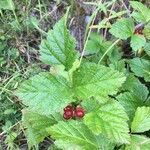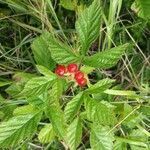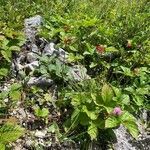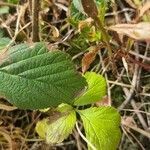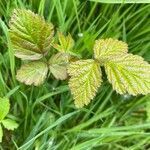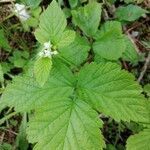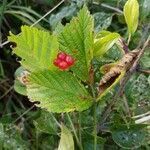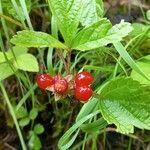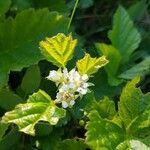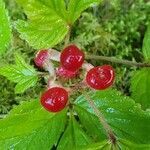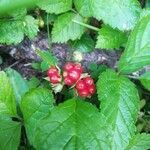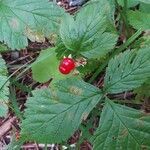Herbs 20–60 cm tall. Stems greenish brown, terete, slender; sterile stems creeping, with minute needle-like prickles, sparsely pubescent, sometimes with stalked glands. Leaves usually compound and 3-foliolate, rarely simple and divided; petiole 2–3.5 cm, pilose, with minute needle-like prickles; lateral leaflets subsessile, petiolule of terminal leaflet 1–2 cm; stipules free, on flowering branches ovate or elliptic, 5–8 × 3–5 mm, on creeping branches narrower, lanceolate or linear-oblong, pubescent, margin entire; blade of leaflets ovate-rhombic or oblong-rhombic, terminal leaflet 5–7 cm, slightly longer than lateral leaflets, both surfaces pubescent, more densely so along veins abaxially, base subcuneate or obliquely subcuneate, margin often coarsely doubly serrate, rarely incised-serrate, lateral leaflets sometimes 2-lobed, apex acute. Inflorescences corymbs or flowers several in clusters; peduncles unequal in length, shorter ones ca. 5 mm, longer ones to 3 cm; bracts ovate or elliptic, rarely linear-oblong, pubescent, margin entire. Pedicel 6–10 mm, pilose, with minute needle-like prickles, often with stalked glands. Flowers less then 1 cm in diam. Calyx turbinate, sometimes pelviform in fruit, abaxially pubescent; sepals ovate-lanceolate, 5–7 × 1.5–2.5 mm, apex acuminate. Petals white, spatulate or oblong, 6–9 × 3–5 mm, glabrous, base clawed, erect. Stamens many, much shorter than petals; filaments erect, base inflated, apex subulate, incurved. Pistils 5 or 6, nearly equaling stamens. Aggregate fruit red, globose, 1–1.5 cm in diam., glabrous, with larger drupelets; pyrenes oblong, alveolate-pitted. Fl. Jun–Jul, fr. Jul–Aug. 2n = 28.
More
Herbs or subshrubs, to 4 dm, armed or unarmed. Stems usually creeping, ?± woody basally?, sparsely to densely hairy, eglandular, not pruinose; prickles absent or sparse, erect, weak, 1–3 mm, narrow-based. Leaves deciduous, ternate; stipules ?free from petioles?, lanceolate to ovate or elliptic, 6–11 mm; ?petiole 2–11 cm; petiolule of terminal leaflet 8–20 mm; lateral leaflet sessile or subsessile?; terminal leaflets ovate to elliptic, 4–8 × 3–7 cm, base tapered, unlobed, ?lateral leaflets sometimes shallowly lobed?, margins coarsely doubly serrate, apex acute, abaxial surfaces unarmed, sparsely hairy, eglandular. Inflorescences axillary, 1–6-flowered, cymiform or umbelliform. Pedicels unarmed or prickles weak, erect, hairy, eglandular or sparsely stipitate-glandular. Flowers bisexual; petals greenish white, narrowly obovate, 5.5–7 mm; filaments laminar; ovaries glabrous. Fruits red, globose, 0.5–1.5 cm; drupelets 1–10, not or weakly coherent, separating with torus attached. 2n = 28.
A herb. It keeps growing from year to year. It grows 10-15 cm high. The canes can be 40-100 cm long and the fruiting canes extend upwards. The stems have hairs and thorns. The leaves are compound with 3 leaflets. The leaf stalks are long. There are thin thorns under the leaf. There are 3-10 white flowers in groups. The fruit are red berries. They are 5 mm across.
Stony woods and by shady rocks, especially on basic rocks. Birch scrub, talus slopes at elevations up to 1,300 metres in Greenland. Forests (usually shady), shrubby formations, bluffs, stony mountain slopes, bogs.
More
It grows in Arctic and temperate places. In Kazakhstan it grows on stony mountain slopes. In northern China it grows below 3,000 m above sea level.
Can be grown by cuttings or seedlings. Seeds needs stratification.
